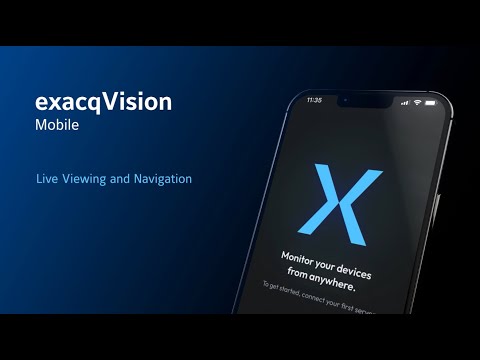Description There are a few reports of customer having no live streams in the views created. When selecting the view to monitor some of the live streams show a black box. This has been seen on view containing 4 live streams as well up to 25 streams. Please note that our application only decodes up… Continue reading Exacq Mobile Application Views show Black Box
Tag: exacqVision Mobile
exacqVision Mobile – Getting Started & Server Connections
This video shows users how to connect to exacqVision Servers and manage Server connections.<br><br> Chapters:<br>00:00 Intro<br>00:25 Connecting to your first server<br>00:39 Connecting with an access code<br>01:12 Connecting using a URL<br>01:34 Quick View<br>02:05 Connecting to additional servers<br>02:22 Managing server connections<br> <br>
exacqVision Mobile – Search, Bookmarks, Export
Learn more about using the exacqVision Mobile app to search for, bookmark, and export recorded events.<br><br> Chapters:<br>00:00 Intro<br>00:09 Searching For Recorded Events<br>02:52 Creating Bookmarks and Cases<br>05:31 Retrieving Bookmarks and Cases<br>06:45 Exporting Recordings<br> <br>
exacqVision Mobile – Live Viewing and Navigation
This video takes a deep dive into general navigation, live viewing, and creating saved views in the all new exacqVision Mobile app.<br><br> Chapters:<br>00:00 Intro<br>00:10 Live<br>00:33 Quick View<br>00:41 Editing Quick View<br>01:17 Audio<br>01:52 Creating and Editing Saved Views<br>03:34 Navigating Between Views<br>03:47 Focus View<br>05:11 Devices Screen<br> <br>
exacqVision Mobile – PTZ, Dewarp, and Security Integrations
Follow along with this video on using the exacqVision Mobile app to control PTZ cameras, dewarp fisheye cameras, and interact with the access control or intrusion detection systems integrated with your exacqVision Server.<br><br> Chapters:<br>00:00 Intro<br>00:09 PTZ Control<br>00:56 Dewarp<br>02:24 Security Integrations<br> <br>
exacqVision Mobile – Event Monitoring
Learn to use exacqVision Mobile’s Event Monitoring feature to receive notifications on events. View our separate video on creating Event Monitoring profiles using the exacqVision Client. <br>
exacqVision Mobile – Quick Start Video
A quick introduction to get started with the exacqVision Mobile app for those users just getting started. We also feature several other videos on exacqVision Mobile covering its use and each feature in greater depth. <br>
Accessing exacqVision from Tablets and Phones using the exacqVision Mobile App
Overview exacqVision Mobile receives live and recorded video from the exacqVision Server The exacqVision Mobile app allows you to use Apple or Android tablets and smartphones to view live video from an exacqVision Server, search for recorded video, and more. To access your exacqVision server over the internet from exacqVision Mobile, additional configuration may be… Continue reading Accessing exacqVision from Tablets and Phones using the exacqVision Mobile App
How to Determine if a Mobile User is Connected Through Remote Connections
Description The exacqVision Mobile application provides the ability to connect straight to the exacqVision Server service, without the use of the exacqVision Web Service, when using server version 24.09 and higher. This connection can be made directly or by means of the Remote Connections feature. This article instructs users on how to determine which method… Continue reading How to Determine if a Mobile User is Connected Through Remote Connections
Remote exacqVision Connection Diagrams
The method used for connecting to an exacqVision system from outside the LAN it resides on will depend on your network configuration and use case. Examples are provided below based on each method. Remote Connections Remote Connections are supported by exacqVision Server/Client 24.09 and above to facilitate connections from the exacqVision Mobile app. When considering… Continue reading Remote exacqVision Connection Diagrams





